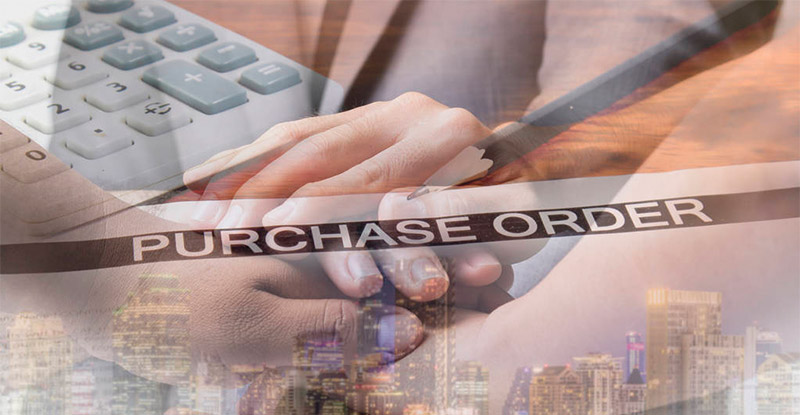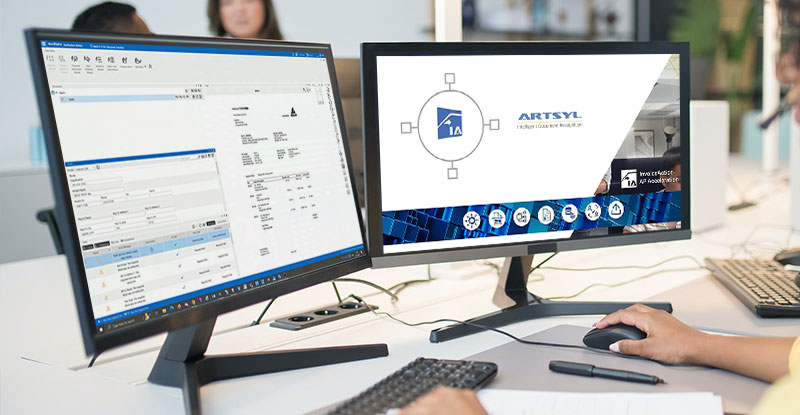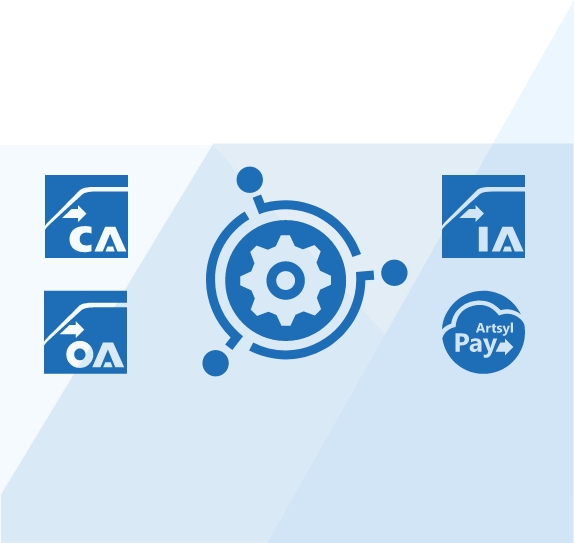As a business owner, you might have often encountered the terms «order» and «invoice» in your operations. While they might sound similar and used interchangeably, they actually serve different purposes. Understanding the difference between the two is crucial for proper bookkeeping, financial management, and satisfying your clients.
In this blog post, we will highlight the key differences between orders and invoices to help you make informed decisions about them.

Transform your order processing with Artsyl OrderAction!
No longer slave over manual data entry, errors, and delays. Experience seamless automation, intelligent data capture, and streamlined workflows.
What is an Purchase Order?
An order is a request for products or services made by a client. It represents a buyer and seller agreement for a particular transaction. When a customer places an order, they provide the details of what they need, the quantity, and any other relevant information.
Before processing the order details, such as availability and pricing, the seller verifies the order details. An order is not a payment request. More precisely, it’s an inquiry that leads to a potential sale.
Intelligent Process Automation Solution
Related Videos
What is an Invoice?
In contrast, an invoice is a payment request issued by the seller to the buyer. It contains the details of the transaction, such as the products or services delivered, the quantities, prices, and payment terms.
The invoice is a legally binding document that indicates the payment due date and the payment methods accepted. The seller sends the invoice to the buyer after delivering the order or completing the services. The buyer must then pay the invoice according to the agreed terms.
What are the typical payment terms mentioned in an invoice?
Typical payment terms mentioned in an invoice include:
- Net 30: Payment due within 30 days
- Net 60: Payment due within 60 days
- Due on receipt: Payment is due immediately
- Specific dates for installment payments and more
The buyer and seller should agree on payment terms before the transaction occurs.
Supercharge your invoice processing with Artsyl InvoiceAction! No longer fall prey to tedious manual data entry, invoice errors, and processing delays. Unlock the potential of efficient invoice management!
Book a demo now
What Types of Orders Are Commonly Used?
In accounting, the concept of «orders» often refers to transactional documents that signify a buyer’s intent to purchase goods, services, or both from a seller. These documents can take multiple forms depending on the nature of the business and the specific type of transaction being conducted. Here are some common types of orders that you may encounter in accounting:
Purchase Orders (POs)
A purchase order is a formal document issued by a buyer to a seller, detailing the types, quantities, and prices for products or services. It serves as an offer to buy and becomes binding when accepted by the seller.
Sales Orders (SOs)
A sales order is generated by the seller and confirms that a certain amount of goods or services will be made available to the buyer at a particular price. This often follows a quote or an estimate and is a confirmation of what will be provided.
Work Orders
A work order is often an internal document that specifies what work is to be completed. This could be used in manufacturing, service industries, or any situation where work is being ordered — potentially within an organization or between organizations.
Job Orders
Similar to work orders, job orders are commonly used in job costing environments. They are specific to each project and detail the work that needs to be completed, the materials that will be used, and other project-specific information.
Change Orders
A change order is a document used to record an amendment to the original contract. This is common in the construction industry where the scope of the project can change, requiring the initial order to be adjusted.
Blanket Orders
These are used for repeat purchases of the same item or service. A blanket order sets the terms (e.g., price, delivery requirements) for multiple transactions over a period of time, reducing administrative costs.
Back Orders
A back order is a type of order used to indicate that there is a demand for a product that cannot currently be fulfilled. This order will be completed when the items become available.
Rush Orders
These are orders that need to be filled as quickly as possible and take precedence over other orders. Rush orders often come with higher costs for expedited service.
Standing Orders
A standing order is an instruction to make regular payments of the same amount to a specific payee. These are common in subscription models or for recurring services.
Each type of order serves a specific function within an organization’s accounting and operational activities. Understanding the difference between these orders can aid in more accurate record-keeping and better financial decision-making.
Significant Differences: Invoice vs. Order
One of the main differences between orders and invoices is the timing. An order precedes an invoice in a transaction timeline. It’s the initial step that leads to a final sale.
On the other hand, an invoice comes after the sale is completed and serves as a request for payment. Another difference is the level of detail.
An order may contain specific details about the products or services the buyer wants. An invoice includes more detailed information, such as the applicable taxes and discounts, shipping and handling fees, and additional costs.
Moreover, orders and invoices have different legal implications. An order is not legally binding; it’s an offer from the buyer to purchase goods or services. The seller can accept, decline, or revise the order depending on their policies and terms.
An invoice, however, is a legal document representing the seller’s entitlement to receive payment from the buyer. Non-payment of an invoice can lead to legal actions, penalties, or damages.
Lastly, orders and invoices serve different purposes in accounting and financial management. An order is part of the sales process and reflects the potential revenue of a business. It does not affect the cash flow until the sale is completed.
On the other hand, an invoice represents the actual revenue earned from a sale. It impacts the cash flow by reflecting the money the business will receive after the payment. However, there’s a different kind of orders that are more closely related to invoices.
Invoices and Purchase Orders: A Different Relation
In business transactions, invoices and purchase orders play distinct but interconnected roles. Let’s explore their relationship and differences.
Invoices and purchase orders are both documents used in the procurement process. The buyer creates purchase orders and serves as a formal request to the seller to provide goods or services.
A purchase order is a document the buyer initiates to communicate their intent to purchase specific goods or services. It includes details such as the quantity, description, price, delivery terms, and other relevant information. Purchase orders are typically created before the actual transaction takes place and are legally binding.
On the other hand, invoices are generated by the seller and serve as a request for payment for the goods or services provided. An invoice is a document the seller generates and sends to the buyer to request payment for the goods or services provided. It includes details such as the quantity, description, price, terms of payment, payment due date, and other relevant information. Invoices are created after the goods or services have been delivered.
Who doesn’t like smooth order processing? Artsyl OrderAction is your ultimate solution! Automate repetitive tasks, accelerate order fulfillment, and enhance customer satisfaction. Discover how our advanced AI-powered technology can revolutionize your operations.
Book a demo now
Key Differences Between Invoices and Purchase Orders
- Purpose: Purchase orders are used to initiate a purchase, while invoices are used to request payment.
- Direction: Purchase orders are created by the buyer, while the seller creates invoices.
- Timing: Purchase orders are generated before the transaction occurs, while invoices are generated after the goods or services have been provided.
- Legal Obligation: Purchase orders serve as a legally binding agreement between the buyer and seller, while invoices outline the amount owed and payment terms.
In summary, purchase orders are used to initiate a purchase and communicate the buyer’s requirements, while the seller generates invoices to request payment for the goods or services provided. Both documents play crucial roles in procurement, ensuring clear communication, accountability, and proper financial transactions between the buyer and seller.
Purchase Order and Invoices Best Practices
One of the most critical aspects of financial management is processing purchase orders and invoices. In this blog post, we’ll explore some of the best practices to streamline these processes and help ensure the financial health of your business.
Have a transparent purchase order process
The first step to ensuring the smooth processing of purchase orders and invoices is to establish a straightforward process for generating and approving purchase orders. This should include specific instructions on what information must be included in the order and who will approve it.
By creating a transparent process, you can minimize the risk of errors or missed approvals, leading to delays in payment or incorrect charges to your account.
Utilize an electronic invoicing system
One of the most significant benefits of using an electronic invoicing system is the reduction of paper-based processes. Electronic invoicing allows faster processing, lower costs, and increased accuracy compared to manual methods.
Additionally, electronic invoicing provides transparency and accountability, giving you a clear record of all transactions, which can be helpful in auditing and reporting.
Use invoice and order automation
Automation can significantly streamline the purchase order and invoicing process by eliminating manual tasks and reducing the risk of errors. By automating your invoicing and purchase order processing, you can save time and money, decrease the risk of duplicate or incorrect payments, and potentially reduce the need for manual intervention.
Practice good record-keeping
Accurate record-keeping is essential for ensuring the financial health of your business. By maintaining a clear record of all purchase orders and invoices, you can quickly identify errors or discrepancies and take appropriate action. This can also help you to identify areas of your business where you may be overspending or not receiving the best value for your money.
Prioritize vendor relationships
Developing solid relationships with your vendors is a critical aspect of the invoicing and purchase order process. By establishing open lines of communication and maintaining positive relationships, you can help ensure that your orders are processed correctly, and payments are made on time.
Additionally, by working closely with your vendors, you may be able to negotiate better pricing or terms, which can help drive savings for your business.
Managing your finances efficiently is essential to the success of your business. By implementing best practices for purchase orders and invoicing, you can streamline processes, reduce the risk of errors, and ensure the financial health of your enterprise.
By prioritizing these practices and keeping your financial records up to date, you can make informed decisions that will help drive growth and success for your business.
Ready to revolutionize your accounts payable?
Artsyl InvoiceAction is the ultimate solution for automated invoice processing. Discover how our AI-powered technology can transform your invoice
management processes.
Book a demo now
Final Thoughts: Invoice vs. Order
In conclusion, orders and invoices are two entirely different documents used in sales transactions for different purposes. While orders serve as requests for products or services, invoices are payment requests for completed transactions.
Knowing their differences is essential for legal compliance, financial management, and customer satisfaction. For any business owner, it’s crucial to use them accurately and transparently to maintain the trust of your customers and optimize your revenue.
FAQ
Is a purchase order the same as an invoice?
Simply put, a purchase order is a document used at the beginning of a transaction to request goods or services from a vendor. This document outlines the items to purchase, the quantity needed, and the agreed-upon price.
On the other hand, an invoice is a document sent by the vendor to the purchaser requesting payment for goods or services that have already been provided. While they may seem similar, it’s crucial to distinguish between the two to track and manage financial transactions accurately.
Understanding the nuances of a purchase order versus an invoice is essential to any successful business operation.
Why are purchase orders necessary?
Purchase orders serve several purposes. They clearly record the agreed-upon terms between the buyer and seller, including the purchase scope, pricing, and delivery expectations. Purchase orders also help streamline the procurement process, facilitate accurate inventory management, and ensure proper financial control.
What information should be included in a purchase order?
A purchase order typically includes the buyer and seller information, order number, item details (description, quantity, unit price), delivery address, payment terms, requested delivery date, and any specific terms or conditions related to the purchase.
Can a purchase order be modified or canceled?
Yes, purchase orders can be modified or canceled if both parties agree to the changes. However, it is vital to communicate any modifications or cancellations promptly to avoid confusion and potential disputes.
What is an invoice?
An invoice is a document issued by a seller to a buyer requesting payment for goods or services provided. It includes details such as the seller’s information, buyer’s information, invoice number, an itemized list of products or services, prices, total amount due, payment terms, and payment instructions.
What is the purpose of an invoice?
The primary purpose of an invoice is to request payment from the buyer for the goods or services delivered. Invoices also serve as a record of the transaction, enabling both parties to track and reconcile payments and maintain accurate financial records.
How does an invoice relate to a purchase order?
The seller generates the invoice after the goods or services have been provided, referencing the corresponding purchase order if one exists. It serves as a request for payment based on the agreed-upon terms outlined in the purchase order.
Can an invoice be disputed or questioned?
Yes, in some cases, the buyer may dispute or question an invoice if there are discrepancies, errors, or issues with the goods or services provided. It is important for both parties to maintain open communication and resolve any disputes or questions promptly and amicably.
How should I handle invoices for accounting and record-keeping purposes?
It is recommended to maintain a systematic approach to invoice handling. This includes organizing and storing invoices electronically or physically, reconciling them with purchase orders and receipts, and ensuring proper documentation for financial and tax purposes. Accounting software or systems can help streamline invoice management and record-keeping processes.
Tired of manual order processing bottlenecks? Artsyl OrderAction is here to optimize your operations! Empower your team with intelligent automation, real-time visibility, and accurate order data. Embark on a journey toward seamless order management success!
Book a demo now
Why are purchase orders important in the procurement process?
Purchase orders are vital in the procurement process for several compelling reasons:
- Legal Protection: They serve as legally binding contracts between the buyer and the supplier, outlining the terms and conditions of the transaction. This legal protection helps prevent disputes and ensures both parties are held accountable.
- Record Keeping: Purchase orders provide a clear and documented record of the procurement transaction. This documentation is crucial for audit purposes, financial reporting, and compliance with regulatory requirements.
- Inventory Management: Purchase orders help in tracking and managing inventory levels. By specifying quantities and delivery dates, they enable businesses to maintain optimal stock levels, reducing the risk of stockouts or overstocking.
- Budget Control: They assist in managing and controlling budgets. By listing itemized costs, purchase orders enable organizations to plan and allocate funds efficiently.
- Efficiency: They streamline the procurement process by specifying what is required, when it’s needed, and at what cost. This clarity reduces the risk of errors, accelerates order processing, and ensures timely deliveries.
- Supplier Communication: Purchase orders provide a formal means of communication between the buyer and the supplier. They outline expectations, reducing the likelihood of misunderstandings and fostering better relationships with suppliers.
- Cost Tracking: Purchase orders help in tracking costs associated with each purchase. This transparency allows businesses to analyze expenses, negotiate better pricing, and identify cost-saving opportunities.
- Compliance: They help ensure that purchases align with internal procurement policies and external regulations. This is particularly important in industries subject to specific compliance standards.
In summary, purchase orders play a pivotal role in ensuring transparency, accountability, and efficiency in the procurement process, benefiting businesses in terms of financial control, risk mitigation, and supplier relationships.
What’s the role of electronic purchase order systems in modern procurement practices?
Electronic purchase order systems, commonly known as e-PO systems, play a pivotal role in modern procurement practices by streamlining the purchasing process. These systems enhance efficiency and accuracy through automation, reducing errors and processing delays while offering real-time visibility into procurement activities. They facilitate online approval workflows, allowing quick and convenient multi-stakeholder collaboration, integration with various business systems, and robust reporting and analytics to inform strategic decisions. Additionally, e-PO systems promote cost savings, supplier collaboration, and improved compliance, making them a cornerstone of contemporary procurement efforts that adapt to the digital age while contributing to environmental sustainability through reduced paper consumption.
What’s the impact of late or incomplete purchase orders on supplier relationships and inventory management?
Late or incomplete purchase orders can have significant negative impacts on both supplier relationships and inventory management.
Supplier Relationships: When purchase orders are delayed or incomplete, it can strain the relationship between the buyer and the supplier. Suppliers may perceive late or ambiguous orders as a lack of commitment or professionalism on the part of the buyer. This can lead to frustration, decreased trust, and potentially strained negotiations for future orders. In some cases, it may even lead to suppliers prioritizing other clients who provide clearer and timelier instructions.
Inventory Management: Late or incomplete purchase orders can disrupt inventory management in multiple ways. Without timely orders, businesses risk stockouts, leading to lost sales, customer dissatisfaction, and potential reputational damage. Conversely, over-ordering to compensate for late orders can lead to excess inventory, tying up capital and storage space. This inefficiency can result in increased carrying costs, obsolescence, and potential financial strain. Additionally, inventory discrepancies caused by late or incomplete orders can undermine the accuracy of inventory records and forecasting, making it more challenging to plan and allocate resources effectively.
The impact of late or incomplete purchase orders is two-fold, affecting both the supplier relationship and inventory management. Timely, accurate purchase orders are essential for maintaining healthy supplier relationships and efficient inventory control.
How can businesses effectively manage and track multiple purchase orders simultaneously?
Businesses can effectively manage and track multiple purchase orders simultaneously by implementing robust purchase order management systems, such as procurement software or enterprise resource planning (ERP) solutions. These systems centralize purchase order creation, approval, and tracking, providing real-time visibility into the status of each order. They enable businesses to establish standardized processes, automating routine tasks, reducing errors, and expediting order processing. Additionally, businesses can use reporting and analytics tools within these systems to monitor order status, track expenditures, and identify trends, aiding in decision-making. Effective communication with suppliers and the establishment of clear workflows for approvals and changes further enhance the management of multiple purchase orders. By leveraging technology and well-defined processes, businesses can efficiently handle a high volume of purchase orders, ensuring timely, accurate, and cost-effective procurement.
How can businesses optimize their purchase order process to enhance efficiency and reduce costs?
To optimize purchase order and invoice processes for enhanced efficiency and reduced costs, businesses can implement several strategies:
- Automation: Utilize procurement and invoicing software to automate both purchase order creation, approval, and tracking, as well as the generation and processing of invoices. Automation reduces manual efforts, minimizes errors, and accelerates the entire procurement-to-payment cycle.
- Standardization: Establish standardized templates and procedures for creating and managing purchase orders and invoices, ensuring consistency and clarity in the entire financial process.
- Supplier Collaboration: Foster strong relationships with suppliers, which can lead to negotiated cost savings, bulk discounts, and improved delivery terms for both purchase orders and invoices.
- Streamlined Approval Workflows: Implement efficient approval workflows that enable quick processing of purchase orders and the subsequent invoice verification, reducing delays and ensuring timely payments.
- Budget Control: Set and monitor budgets to prevent overspending and track costs effectively, not only in the purchase order process but also when handling invoices.
- Supplier Performance Analysis: Regularly evaluate supplier performance to identify opportunities for improvement, renegotiation, or even switching suppliers when necessary for both purchase orders and invoice handling.
- Inventory Management: Coordinate purchase orders with inventory levels to prevent overstock or stockouts, minimizing carrying costs, and ensure invoices are processed accurately to reflect the received goods.
- Reporting and Analytics: Leverage data analysis tools to gain insights into procurement trends, spending patterns, and invoice management, enabling data-driven decision-making.
- Compliance: Ensure adherence to procurement policies, regulations, and compliance standards, mitigating financial and legal risks for both purchase orders and invoices.
- Reduce Paper Usage: Transition to electronic purchase orders and e-invoices to save on paper and administrative costs while supporting sustainability efforts.
- Training and Education: Invest in training and development for staff involved in the purchase order and invoice processes to enhance their efficiency and accuracy.
- Invoice Matching: Implement three-way matching, reconciling purchase orders, receipts, and invoices to avoid overbilling or discrepancies and ensure financial accuracy.
- Monitor Changes and Discrepancies: Keep a close eye on changes or discrepancies in purchase orders and invoices and address them promptly to prevent costly errors in both processes.
By implementing these strategies for both purchase orders and invoices, businesses can optimize their entire procurement and payment cycle, leading to increased efficiency, reduced costs, and improved financial practices.




 Purchase Order vs. Sales Order: What is the Difference?
Purchase Order vs. Sales Order: What is the Difference? Purchase Order vs. Invoice: What’s the Difference?
Purchase Order vs. Invoice: What’s the Difference? What is an Invoice? Complete Guide
What is an Invoice? Complete Guide What Is a Purchase Order: Complete Guide
What Is a Purchase Order: Complete Guide Invoice Matching Process
Invoice Matching Process Template for Creating Purchase Orders
Template for Creating Purchase Orders


